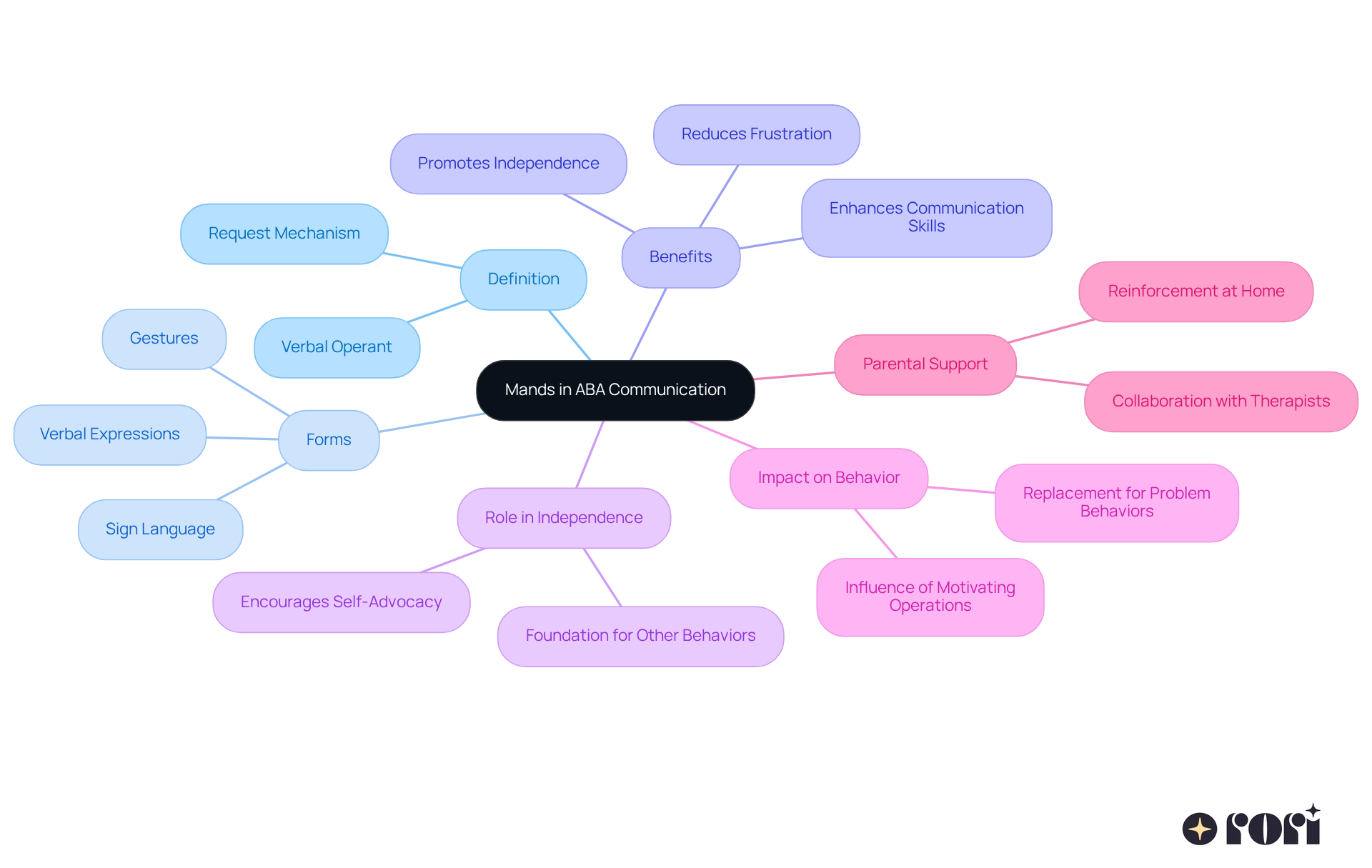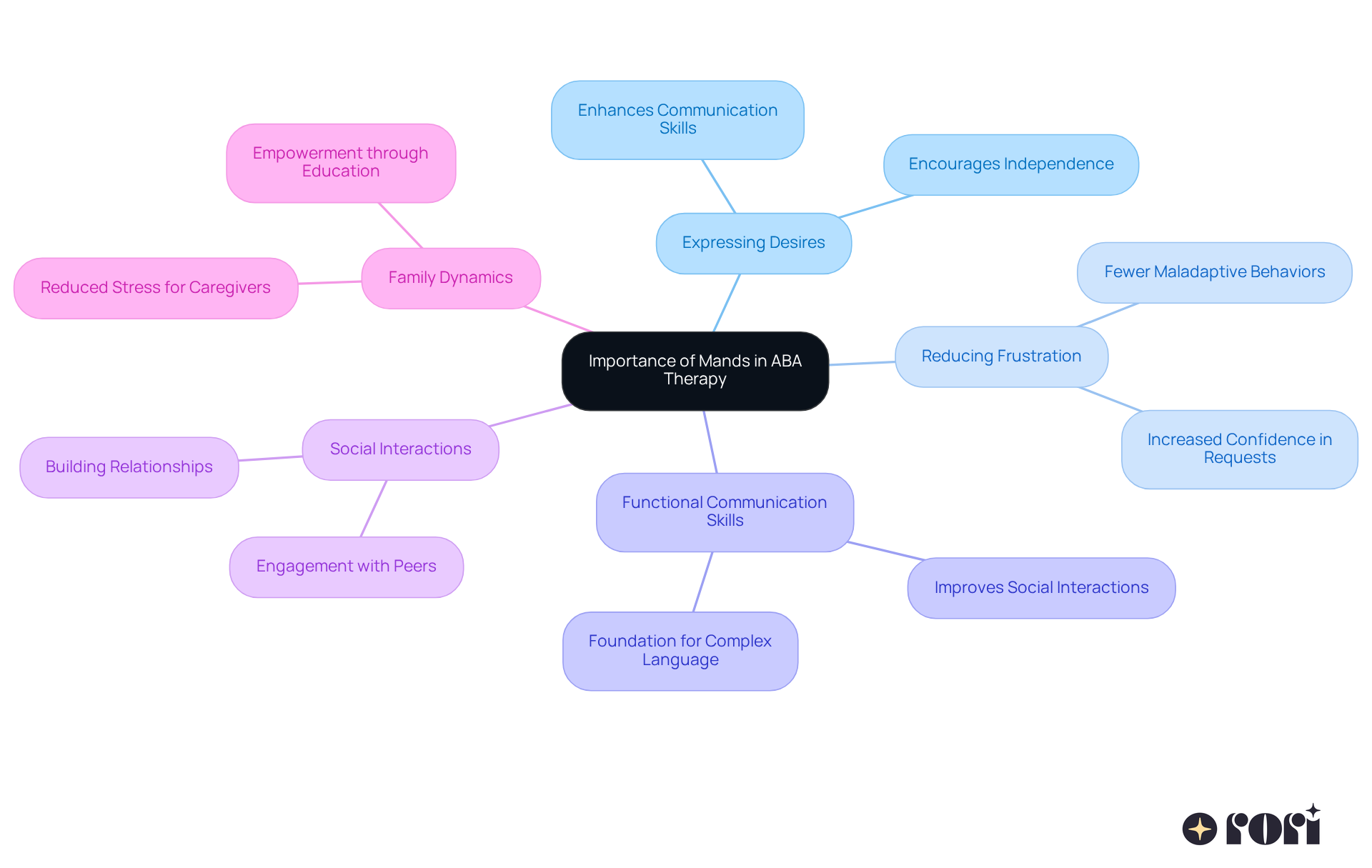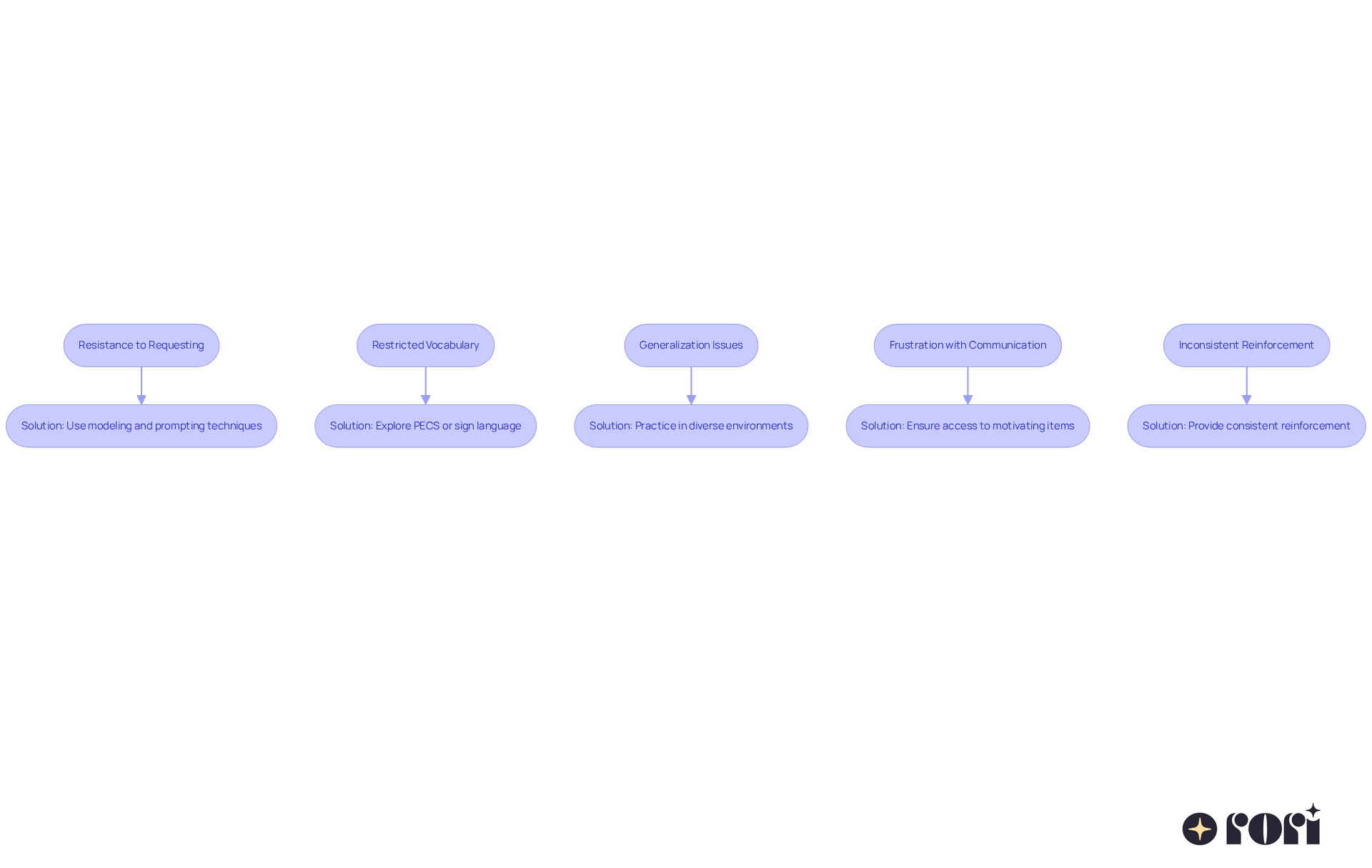This article dives into essential strategies for parents looking to teach mands effectively within the framework of Applied Behavior Analysis (ABA). Teaching mands is a wonderful way for children with autism to express their needs and desires. This not only helps reduce frustration and challenging behaviors but also boosts their overall communication skills through structured reinforcement and practice opportunities.
Let’s explore this together! By focusing on these strategies, we can create a positive environment that encourages our kids to share what they want. Imagine how much easier it would be for them to communicate their needs without feeling overwhelmed. Together, we can enhance their communication journey and make everyday interactions smoother and more enjoyable.
Understanding the intricacies of communication is vital, especially for children with autism. Every word can open doors to connection and expression! Mands, a fundamental aspect of Applied Behavior Analysis (ABA), serve as powerful tools that empower children to articulate their needs and desires effectively. As parents embark on the journey of teaching these essential communication skills, they often face the challenge of transforming frustration into clarity and independence.
So, how can caregivers harness the potential of mands? Not only to enhance their child's communication but also to foster a more harmonious family dynamic? Let’s explore this together! We’re here to help you every step of the way!
In Applied Behavior Analysis (ABA), a 'mand' in ABA is a special kind of verbal behavior that acts as a request, and it’s really important for interaction, especially for kids with autism. For example, when a child says 'toy' to express a desire for a toy, that’s a perfect example of a mand. Mands in ABA can take many forms, such as verbal expressions, gestures, or even sign language, making them versatile tools for communication.
But mands do more than just serve as requests; they play a vital role in promoting independence and reducing frustration by helping children clearly express their needs. Teaching kids how to use mands in ABA can also cut down on those challenging behaviors that they might use instead to get what they want. Research shows that mands in ABA are usually the first verbal operant kids learn, which is crucial for developing other important behaviors.
It’s essential to provide prompt reinforcement when a child successfully requests something they want, as this strengthens their learning process. Mands in ABA can even replace problem behaviors, highlighting their importance in behavioral management. Plus, understanding motivating operations (MOs) is key, as it influences how requests are made.
This understanding of mands in ABA helps parents support their children’s communication growth, fostering an environment where kids can thrive and express themselves confidently. By working with qualified behavior analysts who create personalized plans with measurable goals and evidence-based strategies, parents can really enhance their involvement in their child’s learning journey.
As caregivers learn more about ABA principles, they become empowered to make informed decisions that positively impact their child’s progress. As Akiva Topper wisely notes, 'When individuals learn to use mands in ABA, they gain a powerful tool for obtaining activities, desired items, or information.' Let’s explore this together and see how we can support our little ones in their communication journey!

Mands in ABA are so important in therapy! They help individuals express their desires and needs, which can really lessen frustration and minimize those challenging behaviors we all want to avoid. When parents focus on mand training in ABA, they can really encourage the development of functional communication skills that are essential for social interactions and daily life. Just think about it—when kids learn to ask for things or for help, they face less frustration, which leads to fewer maladaptive behaviors. Studies even show that as children expand their vocal mand variability, they get better at expressing what they want, boosting their overall communication skills.
And there's more! Mands lay the groundwork for more complex language skills, allowing kids to engage meaningfully with their peers and caregivers. Effective mands in ABA training not only fosters independence but also gives children the tools they need to advocate for themselves in different situations. As caregivers learn and grow through education, they gain confidence in supporting their child's development, which can ease stress and improve family dynamics. This empowerment is so vital; it encourages kids to express their preferences confidently, enhancing their social interactions even further. Ultimately, the use of mands in ABA therapy plays a key role in improving the quality of life for children with autism and their families, making communication more accessible and fulfilling. Let’s explore this together!

Teaching your little one to mand in ABA can be a rewarding journey, and as parents, you can make it effective by using some friendly strategies. Understanding the principles of Applied Behavior Analysis (ABA) and the benefits of caregiver education can really enhance your approach.
Identify Motivating Items: Start by figuring out what makes your child light up! It could be their favorite toy, a yummy snack, or a fun activity. Research shows that recognizing what motivates them is key to encouraging inquiries. For example, if they can respond independently with an 80% success rate over three sessions, you’ll have a great benchmark for progress.
Create Opportunities for Mands: Set up fun situations where your child needs to ask for something. Maybe place a beloved toy just out of reach to spark their curiosity. Studies suggest that kids should have plenty of chances throughout the day to practice their mands in ABA, which highlights how important you are in facilitating these moments.
Utilize Prompting Methods: At first, you might need to give a little nudge for them to express their desires. This could be through verbal cues, gestures, or even modeling the request yourself. As they grow, gradually reduce these prompts to help them become more independent. Research shows that this approach fosters self-sufficiency in communication, empowering you to make informed decisions that positively impact your child’s growth.
Reinforce successful mands in ABA by promptly providing what your child requested when they successfully make a request. This reinforcement is crucial, as it encourages them to keep using mands. As M. Alice Shillingsburg noted, "the increasing empirical evidence indicates that behavioral interventions are effective in teaching multiple-word requests for individuals with ASD."
Generalize Across Settings: Encourage your child to practice manding in different environments and with various people. Engaging with family members, teachers, or friends in different settings helps them communicate more naturally and confidently. Studies back this up, showing that practicing in varied environments is essential for effective communication, emphasizing your role in their development.
Be Patient and Consistent: Remember, learning to mand takes time! Be patient with the process and celebrate those little victories along the way. Prompt intervention in ABA therapy has shown to significantly boost communication skills, so your persistence is key for long-term success. Instead of encouraging vague requests like 'more,' guide them toward specific verbal expressions. This clarity leads to a better understanding of their needs. By actively participating, you can enhance your confidence and reduce stress, which ultimately improves family dynamics.
Let’s explore this together! Your journey in teaching mands in ABA can be filled with joy and connection.

Parents often encounter various challenges when teaching their little ones about mands in aba. Let’s explore some common issues together, along with effective solutions that can make a real difference:
Resistance to Requesting: If your child seems hesitant to ask for what they want, it’s essential to figure out why. They might feel frustrated or unsure about how to express their needs. Using modeling and prompting techniques can really help guide them through the mands in aba, making it easier for them to communicate. Active participation from caregivers, supported by Rori Care's educational materials, can enhance this experience, allowing you to tailor your approach to your child's unique needs.
Restricted Vocabulary: For kids with a limited vocabulary, exploring alternative ways to communicate can be beneficial. Have you considered using picture exchange systems (PECS) or even sign language? These tools can help your child express their desires more effectively. Rori Care provides caregiver education that equips you with strategies, including mands in aba, to support your child’s communication development, ensuring you feel confident in your approach.
Generalization Issues: Some children may struggle to use their requesting skills in different settings or with various people. To help with this, practice making mands in aba in diverse environments and with different individuals. This strategy encourages generalization and helps your child feel more comfortable using their skills in various situations. Everyday opportunities, like during meals or playtime, can also reinforce these abilities. Remember, your active involvement in mands in aba is essential for bridging the gap between therapy and daily life!
Frustration with communication can arise if your child feels they can’t express their needs, so it's important to ensure they have access to motivating items and plenty of chances to practice their mands in aba. Celebrate every attempt they make to communicate, no matter how accurate, to reinforce their efforts and boost their confidence. Your involvement is crucial in strengthening these skills outside of therapy sessions. Studies show that children tend to improve significantly when caregivers are actively engaged in their learning journey.
Inconsistent Reinforcement: Consistency is vital when reinforcing successful requests. If your child doesn’t receive what they asked for, they might feel discouraged and less motivated to ask again. By ensuring consistent reinforcement, you help build their confidence and encourage ongoing communication efforts, particularly in terms of mands in aba. The knowledge and skills you gain through caregiver education at Rori Care can enhance your ability to provide this support, leading to better behavioral outcomes for your child.
Let’s work together to navigate these challenges and support our little ones in their communication journey!

Mastering mands in Applied Behavior Analysis (ABA) is a vital step for parents looking to boost their child's communication skills. By understanding and applying effective mand training strategies, caregivers can help their children express their needs and desires more clearly. This not only nurtures greater independence but also reduces frustration. It's a journey that supports the child's growth and strengthens family dynamics as parents become more involved in the learning process.
Throughout this article, we've highlighted how important mands are in facilitating functional communication. They serve as a foundation for more complex language skills, helping children in social interactions and everyday life. We’ve explored various strategies for teaching mands effectively, like identifying motivating items and creating opportunities for requests. We also touched on common challenges, such as resistance to requesting and generalization issues, emphasizing the need for consistency and active parental involvement in this learning journey.
The impact of mastering mands goes beyond individual growth; it enhances the overall quality of life for children with autism and their families. By embracing these strategies and staying patient and consistent, parents can create an environment where their children feel confident to communicate. Empowering children to express themselves enriches their interactions and lays the groundwork for a brighter future. The journey of teaching mands in ABA is filled with potential, and remember, every small step taken can lead to significant changes in communication and connection. Let’s explore this together!
What is a mand in Applied Behavior Analysis (ABA)?
A mand in ABA is a type of verbal behavior that acts as a request. It is particularly important for interaction, especially for children with autism. For example, when a child says "toy" to express a desire for a toy, that is a mand.
What forms can mands take?
Mands can take various forms, including verbal expressions, gestures, or sign language, making them versatile tools for communication.
Why are mands important for children with autism?
Mands help children clearly express their needs, promoting independence and reducing frustration. They can also decrease challenging behaviors that children might use to get what they want.
When do children typically learn to use mands?
Research shows that mands are usually the first verbal operant that children learn, which is crucial for developing other important behaviors.
How can reinforcement affect the learning of mands?
Providing prompt reinforcement when a child successfully requests something they want strengthens their learning process related to mands.
How do mands relate to problem behaviors?
Mands can replace problem behaviors, highlighting their importance in behavioral management.
What is the role of motivating operations (MOs) in mands?
Understanding motivating operations is key as it influences how requests are made and helps in the effective teaching of mands.
How can parents support their children's communication growth with mands?
Parents can support their children's communication growth by working with qualified behavior analysts who create personalized plans with measurable goals and evidence-based strategies.
How does learning about ABA principles empower caregivers?
As caregivers learn more about ABA principles, they become empowered to make informed decisions that positively impact their child's progress in communication and behavior.